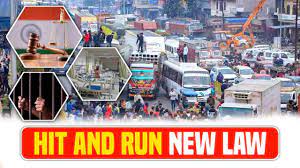
India’s New ‘Hit-and-Run Law’
India’s New ‘Hit-and-Run Law’
GS-II: Governance
(UPSC/State PSC)
Jan. 10, 2024
Why in News:
Transporters and commercial drivers from States like Maharashtra, Chhattisgarh, West Bengal, and Punjab have staged protests against the recent legislation concerning hit-and-run incidents.
- Transporters and commercial drivers are demanding the withdrawal or amendment of Section 106 (2) of the Bharatiya Nyaya Sanhita, 2023.
- They argue that while strict action in hit-and-run cases is necessary, the new law has several flaws that need reconsideration.
- The widely circulated view that Section 106 (2) of the BNS stipulates an imprisonment of up to 10 years and a fine of ₹7 lakh for fleeing an accident spot and failing to report the incident to a police officer/magistrate is grossly incorrect.
Causes of implementation of new law in India:
- In 2022, India registered the highest count of road crash fatalities, exceeding 1.68 lakh deaths.
- This unsettling statistic translates to an average of 462 deaths daily.
- Despite a 5% global decrease in road crash deaths, India witnessed a year-on-year increase of 12% in road accidents and 9.4% in fatalities in the same year.
- The country averages 19 deaths due to road accidents every hour which amounts to nearly one death every three and a half minutes.
- Over half of all road fatalities occurred on national and State highways, which form less than 5% of the total road network.
- With only 1% of the world’s vehicles, India accounts for about 10% of crash-related deaths and incurs an economic loss of 5-7% of its GDP annually due to road crashes.
Hit and Run Cases in India in 2022
- Total Road Accidents: 1,65,121
- Hit and Run Cases: 24,309 (14.6% of total accidents)
- Deaths in Hit-and-Run Cases: 13,056 (18.1% of total road deaths)
- Cases Solved: 2,408 (10% of hit-and-run cases)
Significance of the New Hit and Run law:
- Curbing hit-and-run accidents: Since these cases take the lives of around 50,000 people every year.
- Ensuring accountability: By imposing strict penalties, the accountability and responsibility of drivers involved in such accidents will increase.
- Making necessary reforms in the criminal justice system: The new law replaces the British-era Indian Penal Code (IPC) and makes sweeping changes to the criminal justice system, including changes to the Criminal Procedure Code (CrPC) and the Evidence Act.
- Giving more rights to victims: The new law gives victims the right to prompt compensation, the right to speak during the trial, which can help ensure a fair legal process for individuals affected by hit-and-run accidents.
- Promoting road safety: Imposing stricter penalties will help in promoting road safety and discouraging dangerous driving behaviour.
Way forward:
- The way forward is to revisit and reconcile these two clauses so that more than 35 lakh truck drivers in the country are not treated unfairly, apart from individual vehicle drivers.
- For instance, an exception has been made under 106 (1) of the Bharatiya Nyaya Sanhita (BNS), 2023 for doctors in the event of rash or negligent acts, where the punishment will be up to two years with a fine.
- This limited categorisation is problematic and is against the principles of equality, as the liability of a wide variety of people working in other sectors also needs to be moderated.
- Section 106 (2) is particularly contested and protested by truck drivers, and this section has the scope to be revisited.
- This section does not differentiate between rash and negligent driving as two separate types. In order to provide a graded liability and commensurate punishment, the acts of rash driving and negligent driving must be separated and placed under different degrees of liability so that all incidents of this nature are not bracketed into one, causing prejudice to the actors.
- Arguably, this determination of the actor’s liability has to consider contributory factors in negligent acts such as the behaviour of commuters, road conditions, lighting on the road, and other similar factors. In such a situation, the applicability of one clause fitting to all categories will serve as prejudice against drivers in different circumstances.
- Instead of ruling 10 years of imprisonment for all cases, the same could be categorised in different scales based on liabilities so that the apprehensions of the drivers could be put to rest. Further, there are many ambiguities about this clause, particularly among drivers.
- Hence, it is necessary to mention that in cases of accidents resulting in grievous/straightforward injuries, the corresponding classified clauses of liabilities will apply, and that the applicability of Section 106 (2) will be invoked only in the event of death due to an accident.
- The road accidents resulting in minor injuries ought not to be equated with criminal acts.
- Here measures like community service or revoking of driving licences or mandatory driving retests etc. could be the ways to criminalise.
- Mandatory dashboard cameras: Like foreign countries, India is required to install dashboard cameras, commonly known as "dash cams", to provide evidence in the event of accidents.
- Fix infrastructure deficiencies: The government needs to work towards developing and improving infrastructure, which is a major cause of accidents and deaths.
- Accountability: There is a need to fix accountability of officials to get positive results in case of road accidents and deaths.
Conclusion:
The way forward is to revisit and reconcile the two clauses in Section 106 so that more than 35 lakh truck drivers in the country are not treated unfairly.
Source: The Hindu
--------------------------------------
Mains Question:
Discuss appropriate solutions to overcome the challenges related to road accidents and provide relief to the drivers.